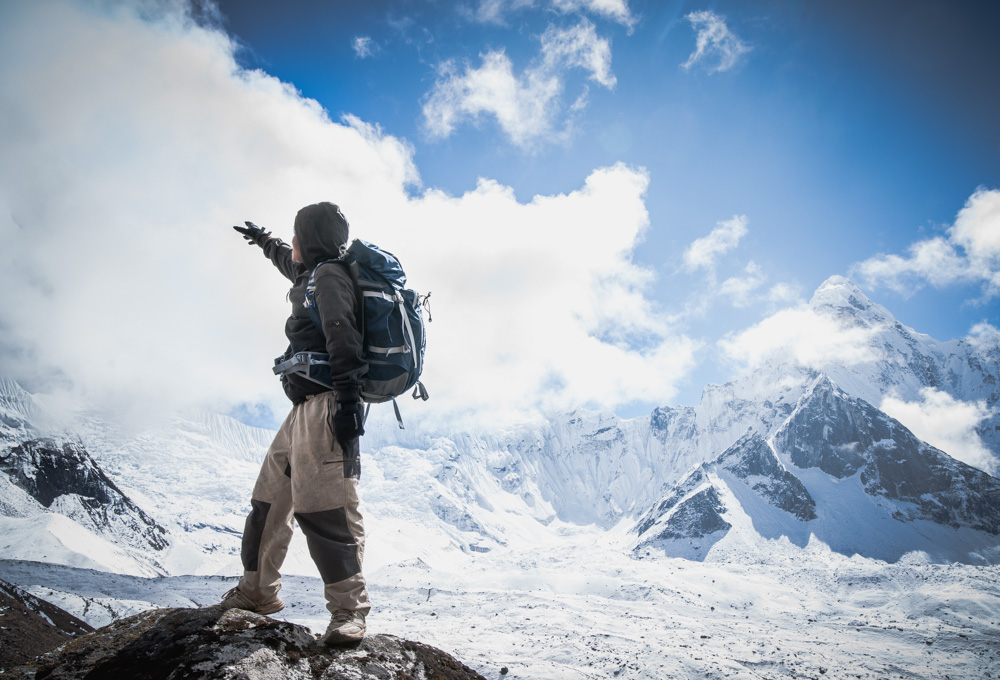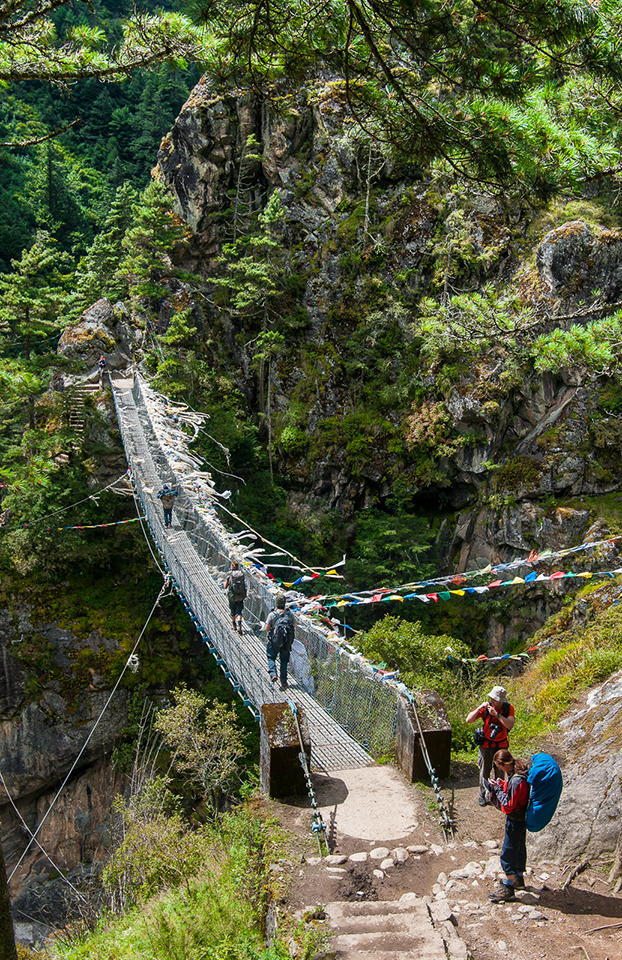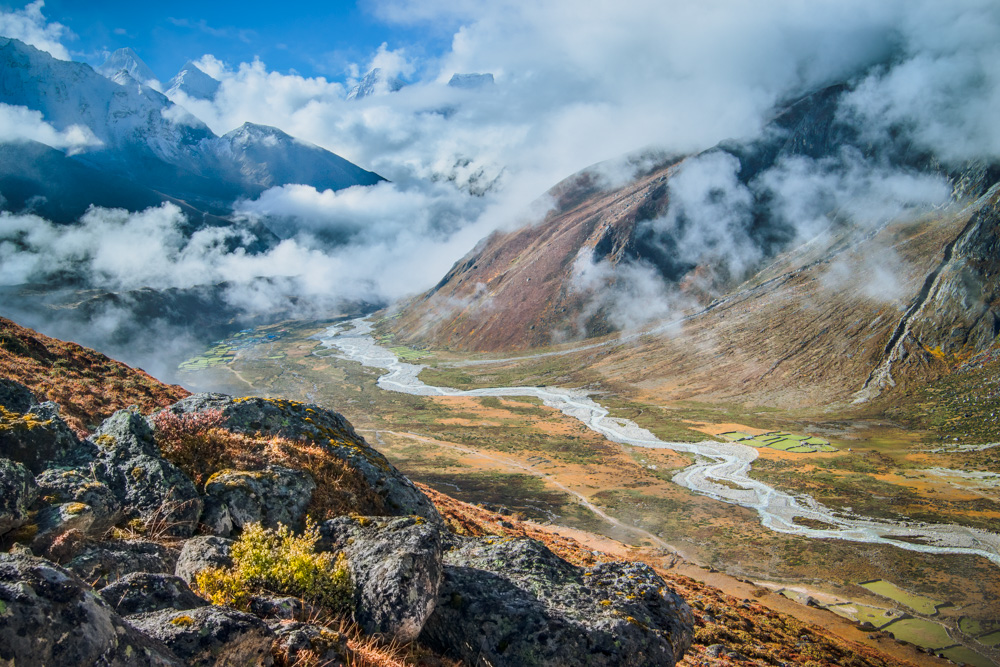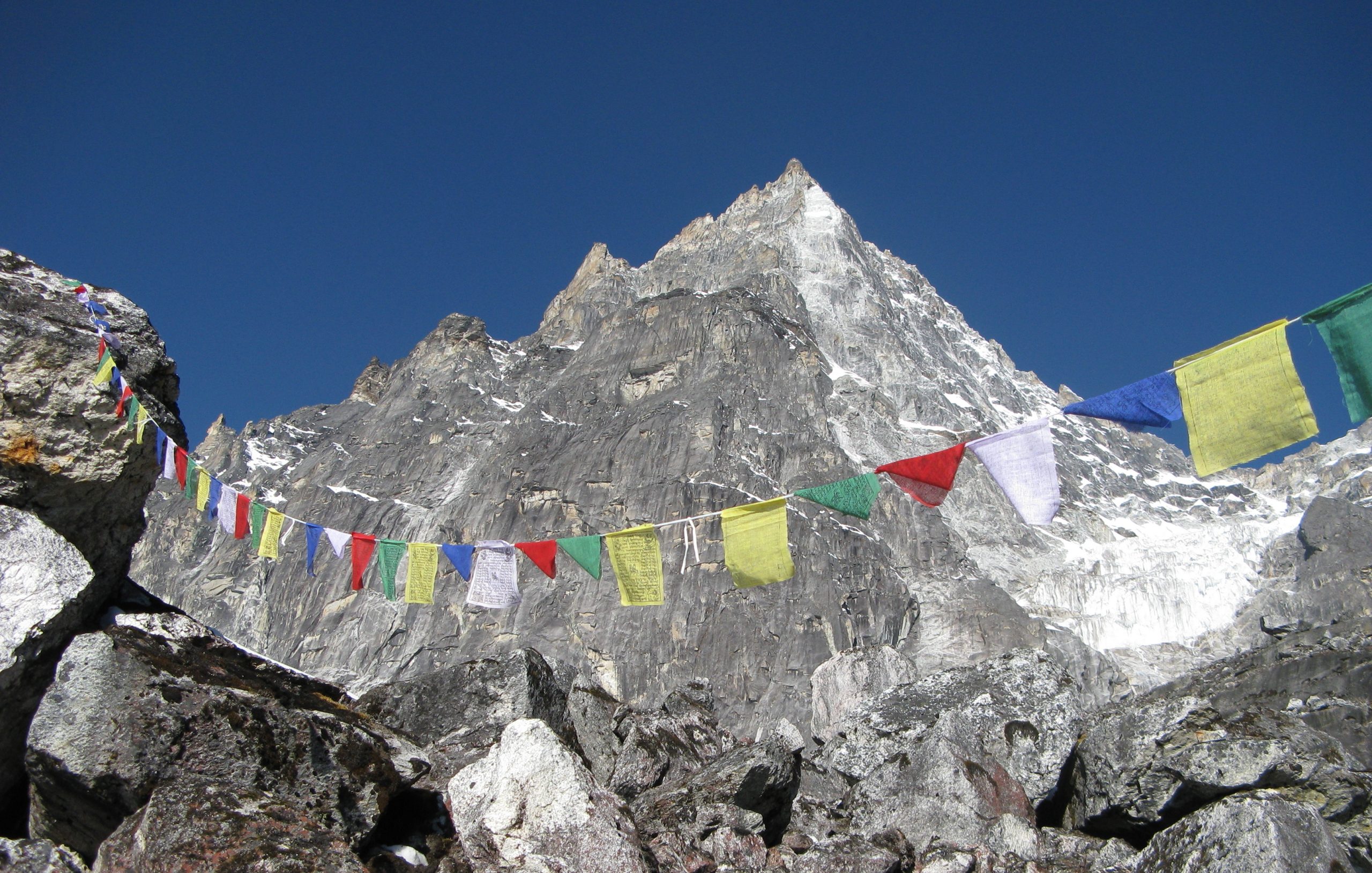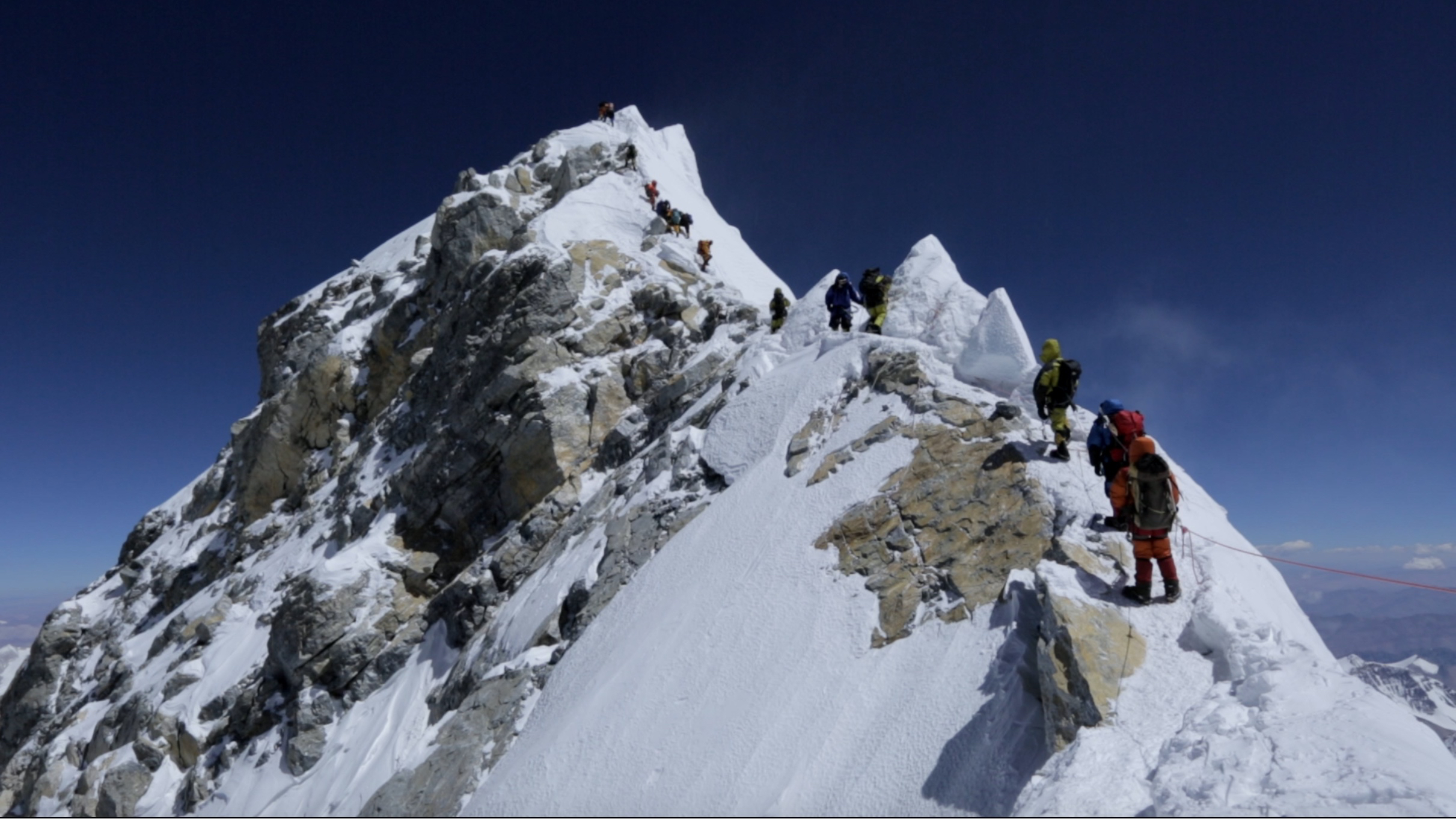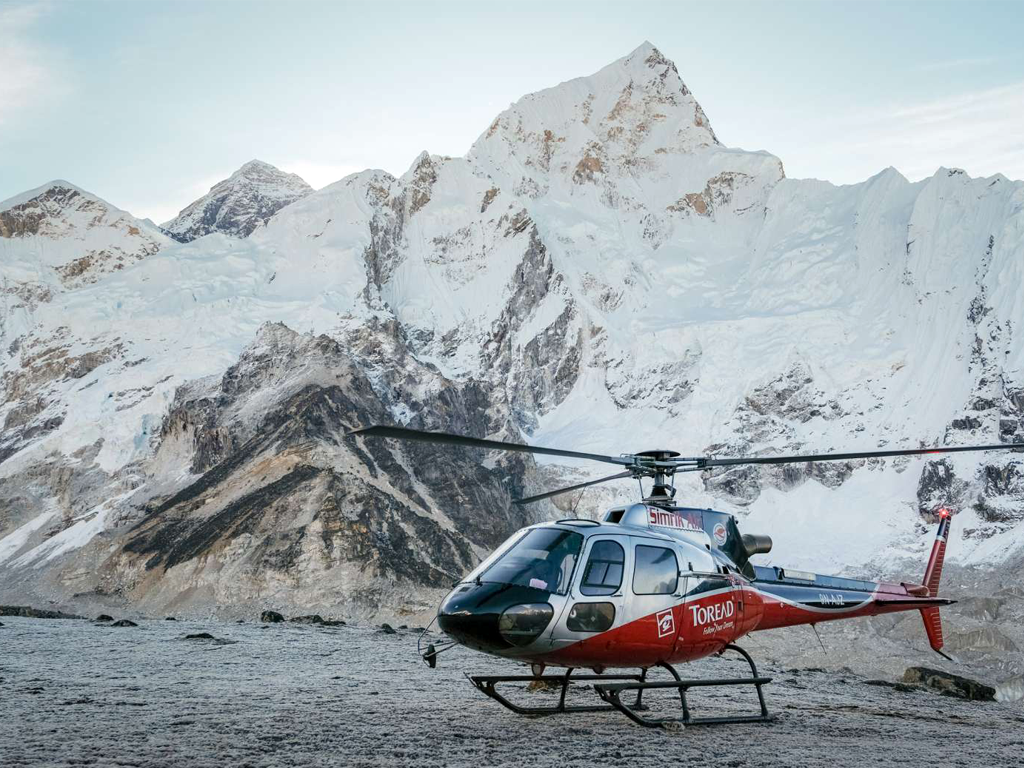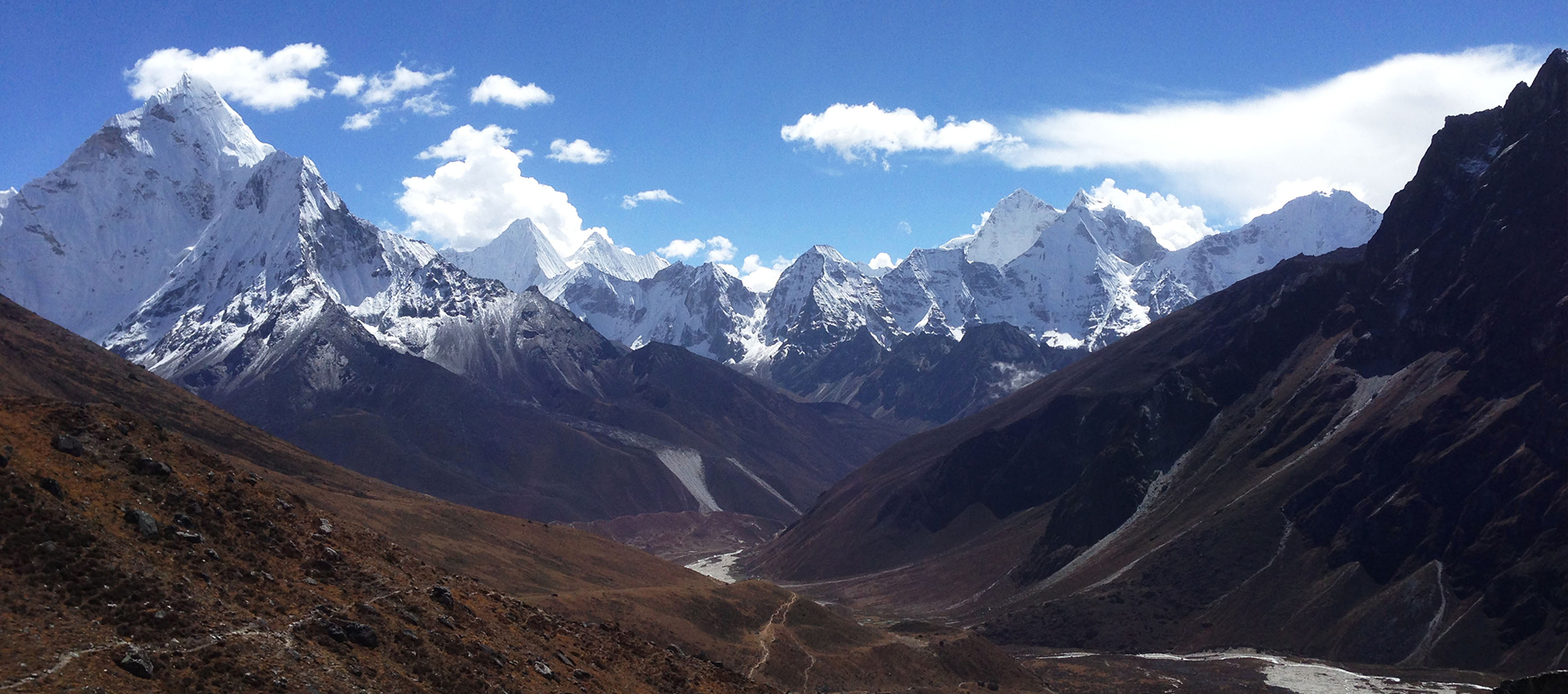
The Everest Three Passes Trek
- Home /
- Nepal /
- Trekking & Hiking /
- Everest Region /
- The Everest Three Passes Trek
The Three High Passes Trek (Renjo-La, Cho-La and Kongma-La) is the adventure of a lifetime trekking through the Everest region over three of the world’s highest passes. The Everest high passes trek offers unparalleled mountain scenery with an opportunity to explore the Khumbu region and the Everest Himalayan range. Three Passes trekking offers not only views of eight thousand meter peaks, but also offers views of many Lesser Peaks including the region’s most beautiful Ama Dablam, Pumori, Cholatse, Khumbutse, Khangtega, Nuptse and Lhotse. This trek is well worth the amazing views and unforgettable experience of crossing these passes. The itinerary is developed for trekkers who are looking for an adventurous and challenging mountain excursion.
On this trek you will observe the beautiful culture of the Sherpa people. The trail passes through traditional villages where Buddhist monasteries, prayer wheels and monuments abound. The trail passes through Sagarmatha National Park which is inhabited by a variety of wildlife including musk deer, blue sheep, Himalayan Tahr, barking deer, blood pheasant, Tibetan snow-cock, and crimson-horned pheasant and domesticated Yak. A major attraction is Everest Base Camp at an elevation of 5340m. Other worthwhile attractions are KalaPatthar 5545m near GorakShepand GokyoRi 5350m near the Gokyo Lakes with most spectacular views of Mount Everest.
Route Map
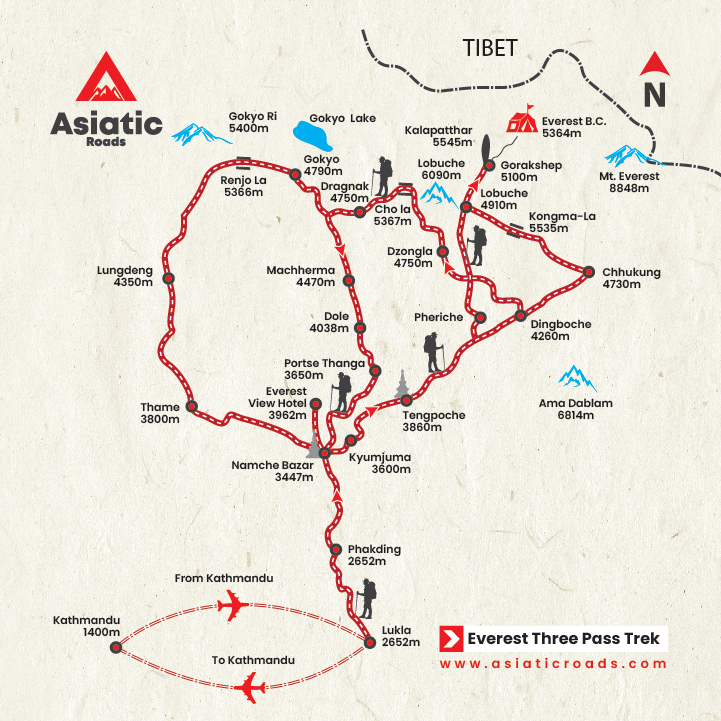
Itinerary In Detail
-
Day 01: Arrival in Kathmandu (1,400 m / 4,592 ft.)
Upon arrival in Katmandu’s Tribhuvan International Airport, meet, assist and transfer to hotel. After welcome refreshments and room check in the hotel, there will be a short briefing and orientation about the trip. Rest of the day is free for leisure.
Overnight at hotel.
-
Day 02: Trekking preparation and sightseeing day in Kathmandu.
Am: After breakfast, proceed for a sightseeing tour of Kathmandu City. It includes visit to the Bouddhanath Stupa, the biggest stupa in Nepal. This is also called by many as Khasti Chitya, is one of the oldest stupas in the country. The stupa, a well-known Buddhist pilgrimage site, is included in World Heritage Cultural site list by UNESCO. With diameter of about 100m and 40m height, Buddhanath holds its place among the largest Stupa in the world!
Later proceed to Pashupatinath Temple, with its astonishing architectural beauty, stands as a symbol of faith, religion, culture and tradition. Regarded as the most sacred temple of Hindu Lord Shiva in the world, Pashupatinath Temple’s existence dates back to 400 A.D. The richly-ornamented pagoda houses the sacred linga or phallic symbol of Lord Shiva. Thousands of pilgrims from all over the world come to pay homage to this temple that is also known as ‘The Temple of Living Beings’, which is listed UNESCO world heritage Site. Later transfer back to hotel for some rest and refreshment.
After visiting Pashupatinath Temple proceed for sightseeing tour of Kathmandu Durbar Square. Listed as one of the eight Cultural World Heritage site by UNESCO, Kathmandu Durbar Square is a cluster of ancient temples, palaces, courtyards and streets that date back to the 12th and 18th centuries. The square is known to be the social, religious and urban focal point of the Capital City. The Palace Complex was the royal Nepalese residence until the 19th century and was the site of important ceremonies, such as the coronation of the Nepalese monarch. We can also visit Temple of Living Goddess “Kumari”, and the Kasthamandap Temple, which is believed to be constructed from the wood of a single tree from which Kathmandu derives its name.
Pm: Free for trek preparation – briefing and orientation etc.
Eve: Traditional Welcome dinner followed by Nepali Cultural program.
Overnight at hotel.
-
Day 03: Fly To Lukla & start Trek to Phakding (2,652m / 8,700 ft.) – 3 hrs.
Early morning transfer to the airport to fly to Lukla (2880m). This 45-minute flight provides a magnificent entry to the trek. It highlights the snowline of the Himalayan Range in the north and the rugged landing at the Lukla airport, which is said to be one of the most spectacular flights in the world. Upon arrival the guide will arrange the porters at the nearby lodge. During this break, the guests are welcome to explore this bustling town on top of a hill with rows of houses, hotels and shops lining both sides of the traditional cobbled street.
The trek starts by following the trail leading to the northwest direction through the narrow street, which immediately descends from the end of the village on a trail through the open hillside. The trail is well defined and there are many shops and lodges catering to the trekkers. This day’s trek is an easy one and ultimately descends to the river at Phakding (2,652m).
Dinner and overnight at teahouse lodge.
-
Day 04: Trek to Namche Bazaar (3,447m / 11,300 ft) – 5~6 Hrs
Leave the main village and the follow the trail on the left bank of the Dudh Kosi River. It is a pleasant walk for the first half of the day as one passes through agricultural countryside and small wayside villages. Just before lunch, there is a steep climb of about 20 minutes to arrive at Monjo for Lunch. After lunch, trek up to the check post to check the permits and enter into the Sagarmatha National Park. Descend for 10 minute and then cross a suspension bridge to arrive at Jorsale (2,800m). Pass through several small villages and beautiful pine forest. This is a busy trail with plenty of human interest.
Our first good views are of west ridge of Kusum Kangru (6,339m). Follow the Dudh Kosi River, crossing a rickety suspension bridge, which is in a dilapidated condition, and then slowly climb up a very steep trail to Namche Bazaar. Near half waypoint, we enjoy our first views of Mt. Everest (8,848m), Nuptse (7,879m) and Lhotse (8,383m) – the big three. The climb is for nearly 3 hours as one gain in altitude making breathing difficult due to rarified air. Arrive at a gate with a sign saying, “Welcome to Namche Bazaar” but it is very misleading as it takes another 20 minutes to arrive at the main town.
This prosperous town is the largest in Khumbu. Mt. Thamserku (6,648 m) and Kwangde Ri (6,624 m) loom along the east and west of the village. The sacred mountain Khumbila (5,707 m) dominates the skyline along the west.
Dinner and overnight at teahouse lodge.
-
Day 05: Rest & acclimatization Hike to Shyangboche Everest View Hotel (3,880 m / 12,727 ft.) - 3/4 hours.
After breakfast start climb to famed Hotel Everest View hotel in Shyangboche at an altitude of 3,880m. It is a steep climb through the rocky train until we reach to Shyangboche Airstrip. From here is it fairly gentle climb mostly through Rhododendron, Pine and Juniper forest. As we slowly gain the altitude we can experience dramatic changes in the vegetation. Once we reach to the summit of Shyangboche we can witness the breathtaking view giant snowcapped Mountains including Mt. Everest (8,848m), Lhotse (8,516m), Thamserku (6,648 m), Kwangde Ri (6,624 m), Khumbela (5,761 m) & beautiful Mt. Amadablam (6,812 m) any many others.
From here it is a level walk to famed Everest View Hotel. Along the way we can see many Yaks grazing around. We will spend good time at Hotel Everest View having Tea / Coffee while enjoying the panoramic view snowcapped Mountain. Later start descends down to Namche Bazaar for lunch. In the afternoon you are free for a rest or stroll around colorful Namche Bazaar. There are several coffee shops, bakery, book shops and adventure gears shops etc.
Dinner and overnight at teahouse lodge.
-
Day 06: Trek to Devouche via Thyangboche Monastery (3,800 m / 12,464 ft) – 7 Hrs
Walk to the checkpoint to show the permits. Then walk uphill for a short period to reach a huge prayer stone from where the path straightens and we get great views of some of the Himalayan ranges. Later as we walk we descend through the rhododendron forest, watching for the blood pheasant and Imphayan pheasant in the undergrowth. As we reach the valley there is Dudh Kosi River where we stop for a lunch at Phunki Thanga (3,200m), next to several large water driven prayer wheels. The afternoon is spent climbing slowly on a steep trail to the Thyangboche Monastery. Thyangboche lies at the base of Kangtega and is a classic setting with superb views backs up the valley to the Ama Dablam, and the Everest poking its southwest face over the huge ridgeline linking Nuptse and Lhotse. The Thyangboche Monastery is one of the most important monasteries of the Khumbu Region and the late afternoon can be spent visiting this ancient Monastery. It is the traditional place where all Everest Expeditions receive their blessings as they walk in towards the base camp. After visiting Thyangboche Monastery a short, steep and muddy descent to Devouche through theforest of briches, conifers and rhododendrons.
Dinner and overnight at teahouse lodge.
-
Day 07: Trek to Dingboche (4350 m. /14,880 ft.) – 5~6 hrs.
After breakfast, set out on the trail with a short, steep and muddy descent through a forest of birch, conifer and rhododendron to the meadows of Devouche. Continue on a level trail through forests to arrive at a suspension bridge high above the fast-flowing Dudh Kosi River with fine views of Mt. Amadablam. Cross the suspension bridge and climb for another 20 minutes to arrive at a resting place. Continue to climb to a pass and then there is a gentler walk to the village of Pangboche (3985m), which also has a monastery. The monastery lies more on the route to Phortse and is not easily reached from the lower trail and for those who desire to visit the monastery, the trail bifurcates just before the village after the pass and a hard half hour of climb up the ridge brings one to this fabled monastery. At the monastery is housed the Scalp of the Yeti which traveled the world in the 60’s.
After lunch, pass through this village and take the right hand trail through the front yard of a few herders’ huts, over a stonewall. The landscape becomes very interesting as the vista opens before us and we can see the river flowing far down below as we take the trail that has been cut out along the sheer cliffs of rocks. A further, 40 minutes of walking brings us to the upper Pangboche Village from where there is a very steep climb to the ridge before descending to Khumbu Khola. Cross the bridge on a wooden bridge and from the bridge it is a 20-minute walk, usually in fierce winds to the valley of Dingboche.
Dinner and overnight at Dingboche.
-
Day 08: Dingboche – acclimatization day.
As per the study on high altitude sickness, it has been found that most of the people suffer or show signs of Acute Mountain Sickness (AMS) from the altitude of 14,000 ft. Thus it is highly recommended to have a rest day to acclimatize at this altitude before starting an ascent.
Dinner and overnight at Dingboche.
-
Day 09: Trek to Chukkung & excursion around Chhukung Valley (4,730 m / 15,515 ft.) – 3~4 hrs.
Walk past the Dingboche village and after that the trail becomes a gentle uphill as they say in Nepali “Nepali Flat”, till we reach Chhukung.
Dinner and Overnight at Chhukung.
-
Day 10: Trek over Kongma la pass (5,350 m / 17,498 ft.) to Labuche (4,910 m / 16,104 ft.) – 7~8 hrs
We’ll make an early start this morning as we strike out for the first of our Everest trek’s three high passes: Kongma La. Our path leads across the outstretched arm of Nuptse’s glacier, tracing a twisting course through rocky terrain before climbing the Niyang Khola valley to arrive at a series of frozen lakes. We’ll make a steep continuous ascent from here to reach the magnificent Kongma La. Standing at a lofty 5,550 m / 17,498 ft. meters above sea level, this represents the highest point so far on the Everest Three Passes Trek. After enjoying the remarkable alpine scenery and savoring our accomplishment, we’ll begin our descent to the other side. Our path now leads in the direction of Everest’s famous Khumbu Glacier, and we’ve got a tricky bit of downhill trekking ahead of us before we reach Lobuche. We’ll set a slow and steady pace, descending gradually and safely to arrive at our destination after about four hours of hiking from Kongma La. When we arrive at Lobuche, we’ll be more than ready for a good night’s rest!
-
Day 11: Trek to Everest Base Camp (5,360 m / 18,000 ft.) via Gorekshep (5,160 m / 16,925 ft.)
From Lobuche, a short climb brings one to another valley. Travel along the Khumbu Glacier through the jumbled moraines and scattered rocks. The trail continues to slowly contour on the open landscape through an ablation and after about an hour, there is a steep ascent for about 20 minutes. Climb slowly to a ridge and then continue on a trail of rocks caused by rockslides. On a clear day Mt. Everest can be seen looming behind Nuptse. Arrive at the ridge above Gorakshep and then descend to Gorakshep, a settlement with 2 teahouses to stay overnight. This was the base camp for the 1952 Swiss Everest expedition. In 1953 A.D. the British Everest expedition called this “lake camp’. Gork Shep or “graveyard of the crows” has a small lake that is usually frozen and several monuments to climbers who have died during various Everest expeditions. The carved stone in memory of Jake Britenbach, US expedition and the monument of Indian Ambassador H. Dayal, who died during a visit to the Everest Base Camp after the 1965 A.D, Indian expedition, are northeast of the lake. – 3 Hours.
After early lunch in Gorakshep start trek to Everest Base Camp. The trip to base camp, while fascinating, is not spectacular as the ascent of Kala Pattar because there is no view of Everest itself from the base camp. Mt. Lhotse and Mt. Nuptse, which loom over the Base Camp, shades the view of Everest. The trail continues on a ridge from where a small glimpse of Mt. Everest can be seen. At the end of the ridge, a scrabbling descent leads to the entry into Khumbu Glacier. The trail through the glacier is an interesting one in that one can actually feel as if one is inside a fridge with the cold seeping from all sides. The Everest Base Camp is also the site for the base camp for Lhotse and Nuptse. It is not actually a specific site as various expeditions have elected different locations for a semi-permanent camp during their assault on the mountains. Some of the sites that expeditions have used, as base camps are identifiable form debris on the glacier at 5360m or more.
However, the highlight of the trip to this place is the sight of the Khumbu icefall and the trek along the Khumbu Icefall is an interesting and an exhilarating one. Later return to Gorakshep for dinner and overnight.
Dinner and overnight at teahouse lodge.
-
Day 12: Climb Kala Patthar (5,545 m / 16,925 ft.) and backtrack to Dzongla (4,850 m / 15,908 ft.) – 7~8 hrs.
Wake up early and start climbing to Kala Pattar. We take the left-hand side trail and head straight up the hill to Kala Pattar (5,545m) for views of Mt. Everest. The trek up to the top is an arduous one and takes about an hour and half to two to reach it. The mornign is the best time to view Mt. Everest from this vantage point as the sunrise is behind the observer and directly on the mountains in front. The climb to the Kala Pattar though tough, is well worth it as the views from here are breathtaking. The giants of the earth are all around Pumori (7,145m), Everest (8,848m), and China’s peak Changtse (7,553m), Nuptse (7,855m), Lhotse (8,516m), Ama Dablam and many others. Later return to Gorakshep for breakfast.
After breakfast start walk to Dzongla. we follow the main Everest trail back down the valley before bearing right to contour round the hillside above the Tshola Tso Lake before descending to the valley floor and the small huts at Dzongla. Upon arrival prepare for the crossing of the snowfields that lead to the top of the Cho La pass.
Dinner and overnight at teahouse lodge.
-
Day 13: Cross over Chola Pass (5340 m / 17,515 ft) & descent down to Dragnag (5,040 m /16,531 ft) – 7hrs.
The day begins very early to reach the top of the pass in the best possible conditions. From camp we ascend steeply on a narrow trail passing large boulders and huge rock slabs, and keeping to the left of the main glacier. There are a number of cairns lining the route to the snowfield and while the trail is well defined it does involve a little scrambling. Once on the snowfield the angle eases off and we soon reach the top of the pass (5420m) where the views are spectacular and include Baruntse (7220m) and Ama Dablam, as well as a sea of lesser peaks. Do not wander around the snow-field as there are crevasses and we may need to rope up for the pass crossing!
The descent from the pass is steep and care should be taken as we follow the narrow rocky trail down to the Nymagawa valley where we enjoy a packed lunch. From the valley we cross rocky screes and boulders and ascend the short distance to a small saddle that leads downhill all the way on an easy trail to the huts and tea houses at Dragnag.
An early start is recommended. The route lies over the large, uncomfortable broken and scree before starting up the slab rock of the pass itself. Depending on the time of the year the route to the summit snow field of the Chyugima La pass (5240m) may or may not be covered by snow. The decent starts gently before stepping down. The broken ground route leads to the few stone huts, that make up the Dzong La.
Dinner and overnight at teahouse lodge.
-
Day 14: Trek to Gokyo Lake (4,750 m / 15,580 ft.) & Explore fight lake.
As with our previous pass crossings we will have the opportunity to take it easy this morning before setting off towards the Gokyo Lake. After late breakfast we cross the Ngozumpa Glacier to the lake at Gokyo for lunch. After lunch follow the lateral moraines of the Ngozumpa Glacier past Kangchung Peak to a point where the Gyubanare Glacier joins in and from where, climbing the ridge to the left of the small trail gives excellent views of Everest’s North Face.
Dinner and overnight at teahouse lodge.
-
Day 15: Climb Gokyo Ri (5,357 m / 17,570 ft).
Climb Gokyo Ri and return to camp. Unlike the Kalapatthar hill from Lobuche, the foot of Gokyo Ri lies five minutes away from the stream that feeds the Gokyo Lake. After two to three hours of “huff and puff” you reach the summit not to be disappointed for your effort at all, as the views from here are well worth the effort you put in. Everest (8848m), showing more of its northern flank than from Kala Pattar, with Makalu (8475m) further to the east and Cho Oyu (8,153m) towards the north make a mesmerizing view to watch.
Return back to Gokyo Ri after spending a wonderful break at the summit.
Dinner and overnight at teahouse lodge
-
Day 16: Trek over Renjo la pass (5,340m / 17,512 ft.) to Lungden – 7/8 hours.
After very early breakfast start your climb towards Ranjo la pass. You begin walking along the Gokyo lake for an hour. From the edge of Lake Gokyo start steep climb mostly through the rocky train until you reach on top of Renjo la pass at an altitude of 5,360m. From the pass you can have a breathtaking view of Gokyo lakes and panoramic view of Mt. Cho Oyu, Mt. Everest and other giant peak in Everest region. Shortly afterwards, start descends down to Lungden (4,300 m) in Bhotekoshi Valley.
Dinner and overnight at teahouse lodge.
-
Day 17: Trek to Namche Bazaar- 7/8 hours.
Start another long day trek to Namche Bazaar. You begin walking through the Bhote Koshi Valley until you reach to Thame Village for lunch. After a lunch walk down to Bhote Koshi River. Cross Bhotekoshi River on suspension bridge and start pleasant walk mostly thrsough the Rhododendron, Pine and Juniper forest.
Dinner and overnight at teahouse lodge.
-
Day 18: Backtrack to Lukla – 6~7 hours
After breakfast start backtrack to Lukla.
Dinner and overnight at teahouse lodge.
-
Day 19: Fly to Ramechhap (15 min.) and drive to Kathmandu (124 Km / 4 hrs.).
Early morning, fly from Lukla to Ramechhap. Upon arrival, meet waiting vehicle and start drive to Kathmandu.
Eve: Free to stroll around colorful Thamel market and dine at nice restaurant.
Overnight at hotel in Kathmandu.
-
Day 20: Contingency day in Kathmandu.
Spend a free day in Kathmandu. There is an occasional possibility of delay or cancellation of flight between Kathmandu and Lukla. This day can use in case of delay or cancellation of flight.
Eve: Group Farewell dinner at nice restaurant in Kathmandu.
Overnight at hotel.
-
Day 21: Final departure.
Free for final minute packing and shopping until transfer to the airport for final departure.
20 Nights/21 Days Days From
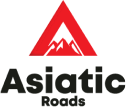
Any Question?
Feel free to call our travel experts.
+977 9851189018, +977 9801089018
info@asiaticroads.com
Whats Include and Exclude
Services Inclued
- All transfers, sightseeing tours & drives as per itinerary in a private tourist vehicle accompanied by Company representative.
- All guided sightseeing tour as per Itinerary in Kathmandu inclusive of applicable monumental fees.
- 4 nights stay at hotel (as above) in Kathmandu on twin sharing basis including American breakfast and all taxes.
- Welcome & Farewell Dinner
- Nepali Welcoming Dinner at a Nepali authentic restaurant in Kathmandu.
- 16 nights / 17 days Everest High passes Trek inclusive of accommodation at teahouse lodges on sharing basis, all major meals (breakfast, lunch and dinner)
- Services of an experience English speaking Trek Leader, Sherpa assistant/s.
- Services of Reliable and strong porter/s (One for every two clients).
- Sagarmatha National Park & Pasang Lamu Rural Municipal development fees.
- Insurance for Trekking Support team includng porters.
Services not Inclued
- International airfares and airport departure taxes.
- Nepal entry visa (US$ 50) per person for 30 days multiple entries.
- Airfare for sector Kathmandu / Lukla / Kathmandu (Quoted Seperately)
- Lunch and dinner except welcome and farewell dinner while staying at hotel in Kathmandu.
- Items of a personal nature such as; laundry, bar bills, alcoholic beverages (except on welcome dinner), extra mileage, optional tours such as Mountain Flights, telephone calls, internet services, personal gratuities as tips to guides, bell-hops or hotel porters, drivers, etc.
- Comprehensive Travel Insurance or “Umbrella Insurance” to cover – Illness, hospitalization, travel medicines, loss of valuables, thefts, change of itinerary, flight and tour cancellations due to unavoidable circumstances and most of all Emergency Helicopter Charter for evacuation purpose.
- Any items that are not mentioned in above the costs include section.
Other Costs (if Applicable)
| Particulars | Cost per person in US Dollars |
|---|---|
| 2~3 Pax | 2,080.00 |
| 4~5 Pax | 1,670.00 |
| 6~9 Pax | 1,630.00 |
| 10~12 Pax +1 Free Tour Leader | 1,610.00 |
| 13~14 Pax +1 Free Tour Leader | 1,581.00 |
| 15 & Above +1 Free tour Leader | 1,530.00 |
| Single Supplement (Only for Kathmandu hotels) | 300.00 |
| Airfares for sector Kathmandu / Lukla / Kathmandu | US$ 360.00 net per person. |
Cost Note
Note: Domestic airfare is extra from above mentioned tour cost which is subject to change without prior notice.
Accomodations
Accomodation (Hotels envisaged or similar)
| Kathmandu | Hotel Tibet or Similar | 4 | BB |
|---|---|---|---|
| On Trek | Teahouse / Trekkers Lodges | 16 | AP |
20 Nights/21 Days Days From

Any Question?
Feel free to call our travel experts.
+977 9851189018, +977 9801089018
info@asiaticroads.com
20 Nights/21 Days Days From

Any Question?
Feel free to call our travel experts.
+977 9851189018, +977 9801089018
info@asiaticroads.com
Reviews
In my 2 week stay, John was very professional and took me around to experience all that Kathmandu and surrounding areas has to offer. Sites were seen and many locals were met through John’s network.

Steven Stone
TravellerIn my 2 week stay, John was very professional and took me around to experience all that Kathmandu and surrounding areas has to offer. Sites were seen and many locals were met through John’s network.

Steven Stone
Traveller20 Nights/21 Days Days From

